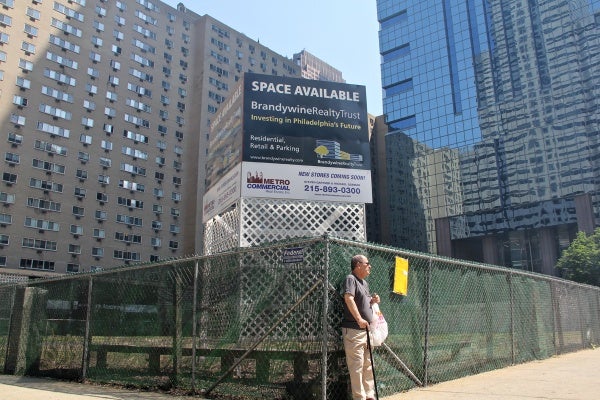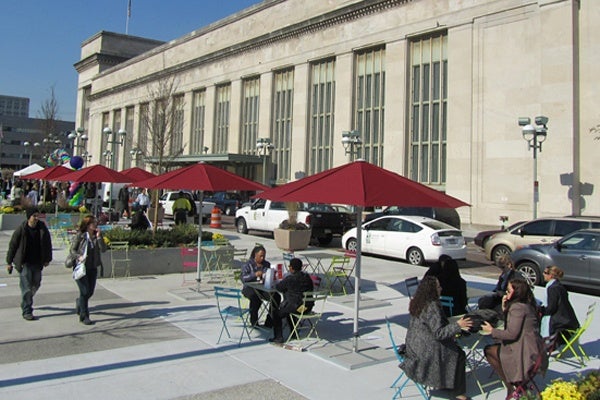Ephemeral pop-ups help fulfill Philly’s public art commitment
Listen-

Gomian Konneh, 17, plays her violin in her East Oak Lane neighborhood. She is a senior at Masterman High School where extracurricular activities are on the chopping block. (Emma Lee/WHYY)
-

-

-

-

Philadelphia’s Redevelopment Authority oversees tens of thousands of vacant lots in the city. The agency has paid artists small amounts to take over select lots for temporary art “pop-up” projects.
A strange industrial sound emanates from somewhere near 10th and Mount Vernon streets, a few blocks north of Spring Garden Street. The constant and rhythmic sound could not be identified by passers-by — it sounded something like a punch-card robot made of power tools.
The corner itself is hard to identify; it’s not really north Chinatown, not really the Loft District, and not really Callowhill. It is not even within the semi-hallucinatory zone known as Eraserhood.
Mark Seawright, who has lived on the block for 34 years, calls his neighborhood Cunningham, “named after the Cunningham Center on Wallace Street.”
Seawright says the neighbors use the vacant lot on the corner for their annual block party at the end of the summer. But he was never able to determine who owns it.
“I tried notifying the city about this lot — they told me it’s not a city lot,” said Seawright. “I tried to find the owner to get them to upkeep. I have no idea who owns this lot.”
As it happens, the lot is owned by the city’s Redevelopment Authority. Seawright was surprised when, suddenly, he found the grass mown, the weeds hacked, and a tent erected where a woman was giving away cups of cold-brewed coffee. This weekly phenomenon — called the Freeshop Coffee Shop — arises at dusk, festooned with colored lights.
It was created by Kathryn Sclavi to bring strangers together, in an unusual place, over a cup of coffee.
“Coffee is the glue that will bind,” she said while wrangling the canopy into place.
‘Little bit of magic for a little bit of time’
This is a temporary coffee counter, operating on Wednesday evenings for just seven weeks, then disappearing forever. Sclavi is able to do this with a $5,000 grant from the Philadelphia Redevelopment Authority, which is funding two other “pop-up” projects in the city.
In mid-September, Sclavi’s will pull up stakes and the site will, once again, become a vacant lot.
“I like the idea of creating something magical,” said Sclavi. “I like the idea that it’s temporary, it sort of arrives and it’s exciting. I like building something out of nothing.
“I like the idea that there is potential in these unused spaces, that you can create a little bit of magic for a little bit of time,” she said. “I like that a lot.”
The Redevelopment Authority, or RDA, normally does big, permanent art projects, such as the Claes Oldenburg Clothespin or Mark di Suvero’s “Iroquois” made of bright red I-beams, which are paid for via a mandate that 1 percent of construction costs on RDA land is spent on public art.
As an experiment in urban planning, the 1-percent program recently started experimenting with temporary pop-ups.
“Are these shorter projects a great idea? What would be the merit of continuing them?” said Julia Guerrero, the program director. “At this point, we have a tremendous opportunity because we can really learn from this process — we’re not on a tight timeline, and we can think about how we can enrich communities.”
Pop-up culture
The term “pop-up” has been popping up a lot in the last few years, referring to gardens, retail, and restaurants. Many things that used to be called simply “events” are now billed as “pop-ups.” The upcoming DesignPhiladelphia festival will launch this fall, not with an opening party, but with an opening pop-up.
Pop-ups can bring attention to abandoned spaces, enliven overlooked communities, and are a low-risk way to try out new ideas. The University City District used this fast-and-cheap, pop-up philosophy to make a permanent change in West Philadelphia: a concrete plaza called The Porch outside the 30th Street train station.
The Porch was developed in small, inexpensive steps, first by putting out tables and chairs and watching how people navigate them; then installing concrete planters; then programming events in the space.
The UCD’s director of planning and urban development, Prema Gupta, says this baby-step approach was ultimately the fastest way to get shovels in the ground.
“The Porch is worthy of being one of Philadelphia’s great public spaces. That was a vision that we had when we started,” said Gupta. “If we were still pushing for that vision, The Porch would still be a blank sidewalk.”
Gupta does not use the phrase “pop-up,” rather hers is an “iterative” approach to a more permanent development.
Even the temporary projects lead to permanent change. For example, the site of the first pop-up garden erected two years ago by the Pennsylvania Horticultural Society, at 20th and Market streets, has attracted a developer.
Brandywine Realty Trust has a vision of a 28-story retail and residential complex on what has been a vacant lot for more than two decades. The city’s zoning board of adjustment could make its decision on the project next week.
WHYY is your source for fact-based, in-depth journalism and information. As a nonprofit organization, we rely on financial support from readers like you. Please give today.


